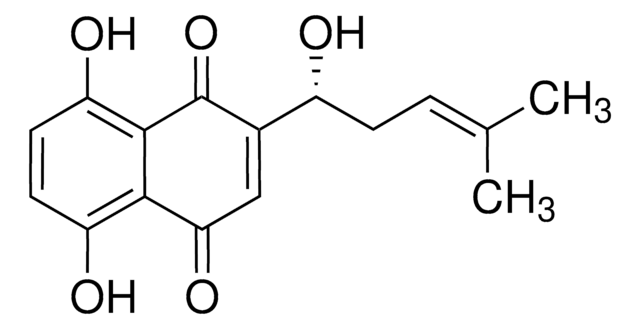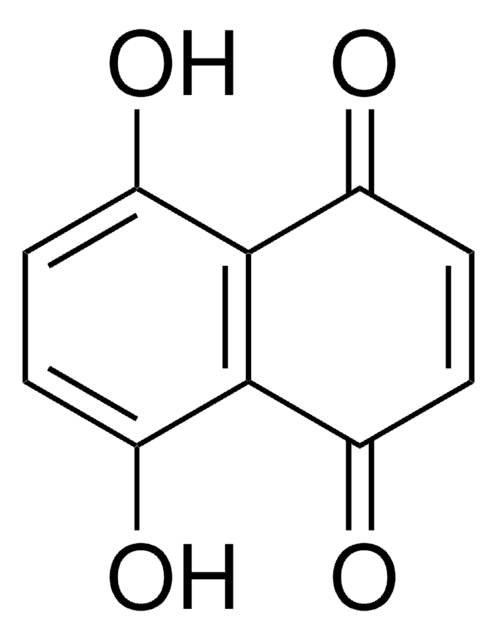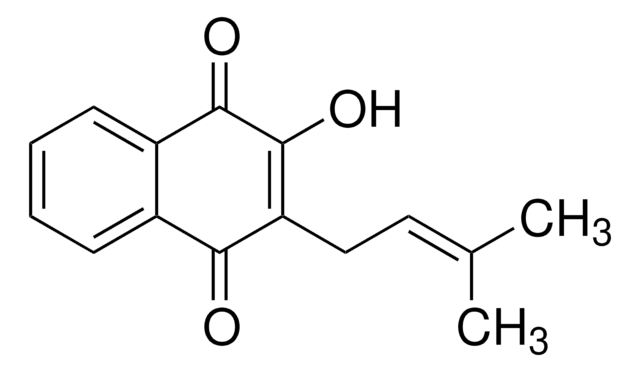S7576
Shikonin
≥98% (HPLC)
Synonym(e):
(±)-5,8-Dihydroxy-2-(1-hydroxy-4-methyl-3-pentenyl)-1,4-naphthoquinone, (±)-Alkannin, (±)-Shikalkin, (±)-Shikonin
About This Item
Empfohlene Produkte
Assay
≥98% (HPLC)
Form
powder or solid
Farbe
red to brown
Löslichkeit
methanol: 1 mg/mL
Anwendung(en)
metabolomics
vitamins, nutraceuticals, and natural products
Lagertemp.
2-8°C
SMILES String
C\C(C)=C\CC(O)C1=CC(=O)c2c(O)ccc(O)c2C1=O
InChI
1S/C16H16O5/c1-8(2)3-4-10(17)9-7-13(20)14-11(18)5-6-12(19)15(14)16(9)21/h3,5-7,10,17-19H,4H2,1-2H3
InChIKey
NEZONWMXZKDMKF-UHFFFAOYSA-N
Verwandte Kategorien
Allgemeine Beschreibung
Anwendung
- to enhance the anti-tumor activity of gefitinib on tyrosine kinase receptor epidermal growth factor receptor (EGFR) in wild-type lung cancer cells
- as an inhibitor of renal aerobic glycosis and a potential
- as an anti-inflammatory agent to test its role to improve lipopolysaccharide (LPS)-induced cardiac dysfunction
- to stimulate bone marrow-derived macrophages (BMDMs) to test the effect of Interferon regulatory factor 1 on cell death
Biochem./physiol. Wirkung
Signalwort
Warning
H-Sätze
P-Sätze
Gefahreneinstufungen
Acute Tox. 4 Oral - Aquatic Acute 1
Lagerklassenschlüssel
11 - Combustible Solids
WGK
WGK 3
Flammpunkt (°F)
Not applicable
Flammpunkt (°C)
Not applicable
Analysenzertifikate (COA)
Suchen Sie nach Analysenzertifikate (COA), indem Sie die Lot-/Chargennummer des Produkts eingeben. Lot- und Chargennummern sind auf dem Produktetikett hinter den Wörtern ‘Lot’ oder ‘Batch’ (Lot oder Charge) zu finden.
Besitzen Sie dieses Produkt bereits?
In der Dokumentenbibliothek finden Sie die Dokumentation zu den Produkten, die Sie kürzlich erworben haben.
Kunden haben sich ebenfalls angesehen
Unser Team von Wissenschaftlern verfügt über Erfahrung in allen Forschungsbereichen einschließlich Life Science, Materialwissenschaften, chemischer Synthese, Chromatographie, Analytik und vielen mehr..
Setzen Sie sich mit dem technischen Dienst in Verbindung.














